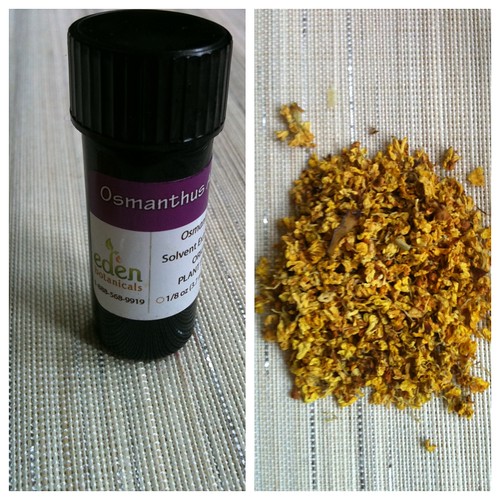Osmanthus Conversations

I'm pleased and excited to begin a new series on SmellyBlog, dedicated to one of my favourite notes: osmanthus. And for the first time - I will be hosting other perfumers who will share their thoughts, impressions and creative process working with this very special raw material.
The idea came to me after visiting Eden Botanicals last summer with my fried perfumer Lisa Fong. We both felt that this osmanthus was so exceptional it called for some special attention. Perhaps a little perfumers conversation on SmellyBlog?
We exchanged some osmanthus goodies - the dry buds, teas mixed with the dry buds, osmanthus oolong and such, and before I even knew it - September came around, and we met again at the LA Artisan Fragrance Salon and Lisa has already created a new perfume surrounding osmanthus. I was clearly behind on my osmanthus series project - in hindsight perhaps a good thing. Because meanwhile I virtually met another talented and gracious natural perfumer, Charna Ethier, and fell in love with her Osmanthus Oolong. About a month later - Nikki Sherritt launched her Osmanthus Red at her Blackbird event (part of the Northwest Perfumers Circuit). It was clearly time for some action on the osmanthus front!
How can I describe osmanthus to you?
Osmanthus (Osmanthus fragrans), sweet olive or tea olive (as it is known in the Southern United States) is a flowering evergreen shrub or small tree from the olive and lilac family, native to warm temperate Asia. It is cultivated as a decorative plant in gardens. In China, the dried flowers are used to infuse both green tea and black tea to create a fine tea called guì huāchá. It is also used in Chinese cuisine to flavour other specialty foods such as jam, cakes, dumplings, soups and a specialty liquor.
It is widely cultivated in Japan, where is it called kinmokusei, and where its incredibly humble, tiny clusters of golden-orange flowers permeate the air at the end of October, releasing a scent in the air that truly cannot be replicated. Marlen Harrison, who lived in Japan for a while, was the first to tell me of this elusive scent in real life, and how he spent hours searching for its source - so perfumey that at first he thought it was a laundry dryer sheet scent until he looked up and saw the osmanthus trees and their tiny, inconspicuous flowers.
And indeed, fresh osmanthus has been largely imitated by popular shampoo brand Herbal Essence and its smell-alikes; and even some laundry detergents and dryer sheets; and only later on in Serge Lutens' Nuit de Cellophane (by which point the scent sadly lost some of its prestige). Somehow, the ethreal quality of fresh osmanthus flowers got poorly interpreted and its lush, rich beauty watered-down in the many inspid aquatic florals that took over the 90's, alongside other "Asian" themes such as water lily and bamboo.
The flowers are solvent-extracted to produce a green, viscous liquid with an unusual floral note with a rich and dense aroma: fruity, leathery and green all at once and reminiscent of leather, apricots, green tea and coumarin. It is sweet, mysterious and exotic. It's fruity intensity is more pronounced in higher quality grades, while poorer quality might present a hint of rancid-oil facet.
Osmanthus is a heart note that is used as the main theme or as an accessory note to add an exotic and unusual dimension to a perfume. It works very well in both rich florals and green florals, orientals, fresh fruity florals, leather and chypre compositions and can make a great floral note in a masculine scent, although it is sadly underused in this regard.
Its beauty is particularly revealed when accompanied with ionone-dominated and tea-like notes (i.e.: green tea, violet leaf, linden blossom, cassie) and fruity floral notes such as jasmine, magnolia, rose and orange blossom. It's main challenge, however, is that this delicate and complex note is often cluttered with too many other dominant notes that tend to conceal it; and the other big technical challenge is that it is a little shy and tends to disappear the more you add of it. This could be in part due to the fickle character of the ionones in it.
Osmanthus flowers are minuscule, and the yield is low - a classic recipe for prohibitive costs. Therefore it is not surprising that it is not a common note to find - especially not in its natural form. You'll find very few perfumes that are a true ode to osmanthus, and even they are often watered down versions of the glorious original. More often, osmanthus will come up in perfumes that are minimalist, as if to attract the potential markets in Asia (Osmanthe Yunnan and Ormonde Jayne's Osmanthus for example, where it is light, ethereal and evoking green tea and cologne); while in others it is incredibly powdery, fruity-sweet and girly (Keiko Mecheri's and The Different Company's rendition). Only rarely will a perfumer explore its darker, leathery sides, as Ineke did in Evenings Edged in Gold, where the ionone and apricot of osmanthus is paired with leathery saffron. And in even rarer cases there is an original take on osmanthus: the bitter, herbaceous rose of 1000 de Patou; and the insanely too-good-to-be-true dessert of Un Crime Exotique. And then, of course, there are the creations of the perfumers that will be part of this little osmanthus series. It will be really interesting to read their own descriptions and insights into this less-known perfume note.
